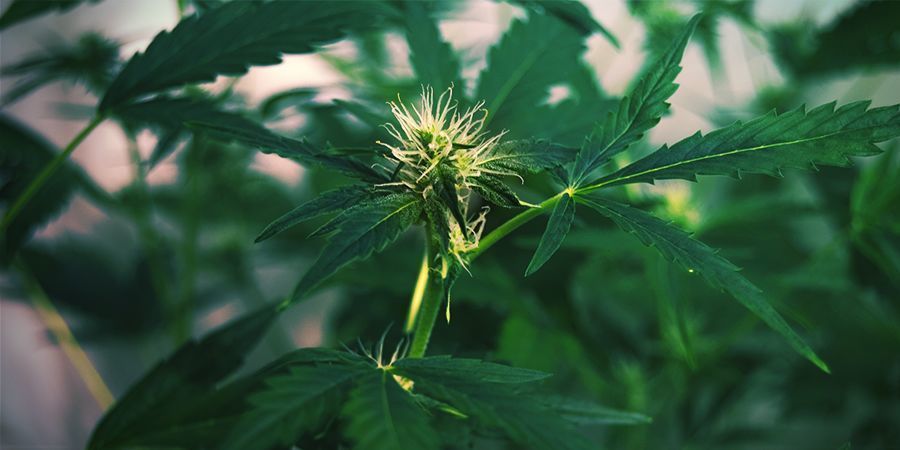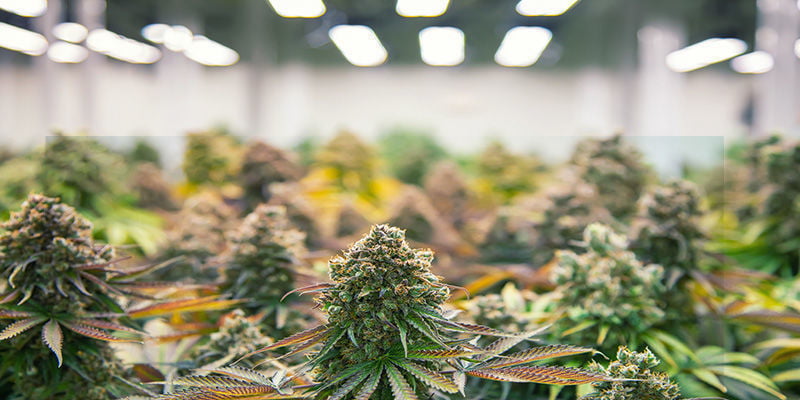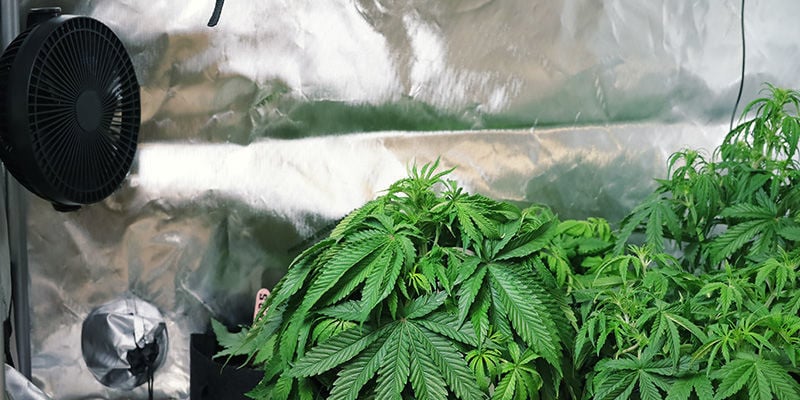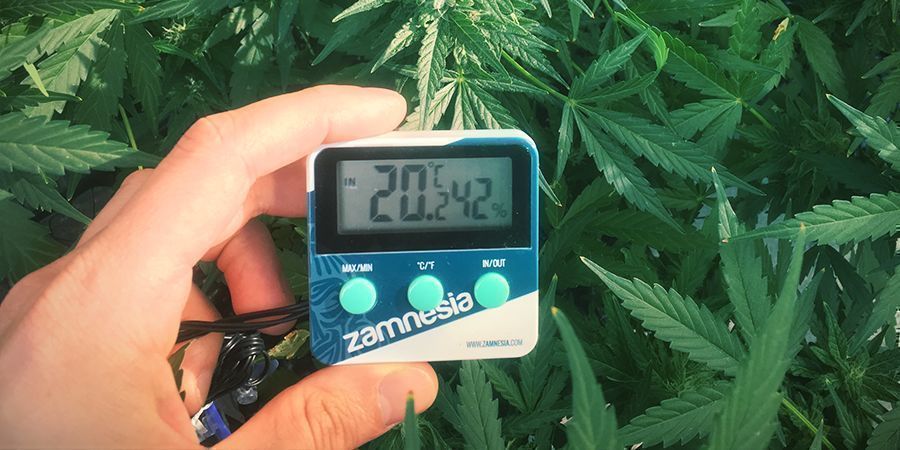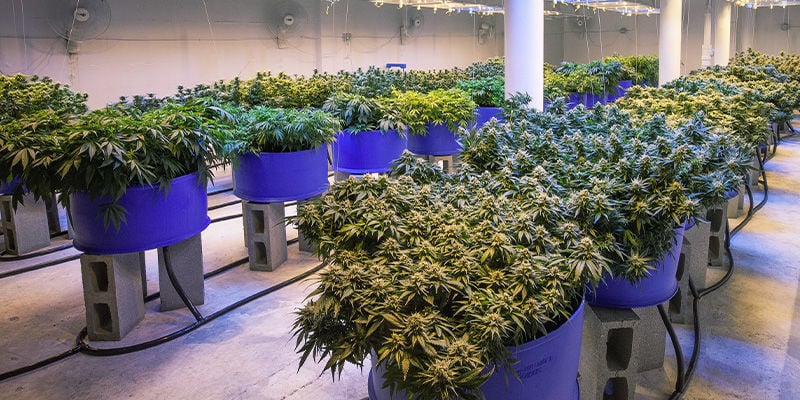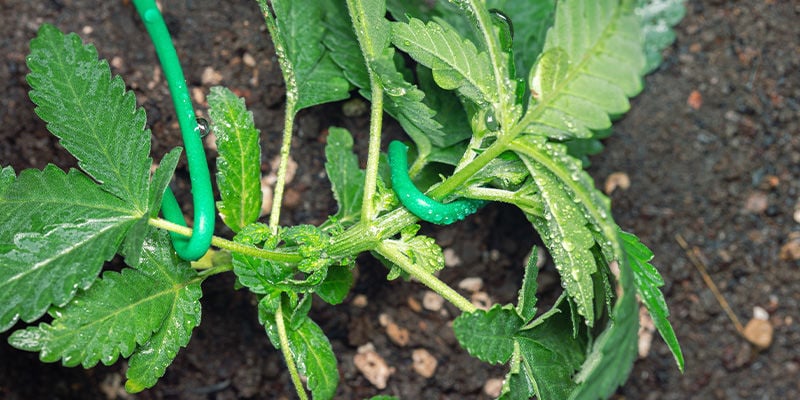
How To Avoid Stretched Cannabis Plants
Stretching: Is it good, bad, or something in between? We break down what causes this phenomenon, and how to prevent it from thwarting your cannabis grow. By taking a few precautions, you can maximise the growth and production of your plants while keeping height and spindly stems in check.
Stretching: It’s something you do when you first wake up in the morning, or after a prolonged period of sitting in front of the computer. But what does stretching have to do with cannabis plants, and why should you be concerned?
Just like stretching can be a signal of sore, tense muscles in humans, it can signify distress or suboptimal development in your weed plants. Let’s explore what’s behind this phenomenon, and if you should be concerned about your cannabis plants’ potential to stretch.
Why and When Do Cannabis Plants Stretch?
As you might imagine, stretching is used to describe accelerated, even excessive, vertical growth in plants. When it comes to cannabis, both environmental and genetic factors contribute to a given plant's potential to stretch.
Flowering Stretch
On the one hand, many cannabis plants are in fact predisposed to exhibiting a “flowering stretch” during the first couple weeks of bloom. You see, before diverting attention exclusively to bud development, plants use the early flowering stage to shoot upwards, sometimes doubling their height in a matter of days.
The change in light cycle is the catalyst behind such an event, although the extent to which a strain stretches during bloom will vary significantly. While it’s true that certain sativa strains, for example, are more likely to stretch markedly during this period than indica strains, whether a plant will stretch or not cannot be determined by strain type alone.
It’s worth noting that the flowering stretch is often viewed as beneficial to the overall growing process, as larger plants are capable of producing more bud sites, and larger returns as a result.
Environmental Factors
During the early flowering stage is not the only time cannabis plants are at risk of stretching. Decisions made during the seedling stage and early vegetative stage can also cause plants to climb upward. Specifically, if plants aren’t receiving enough light, due to a lack of intensity or an excessive distance between the light and the canopy, plants will try to make up for this lack by shooting upwards.
And while this type of growth might be beneficial for newly flowering plants, young plants are less likely to flourish after the stretch.
Why Stretching Cannabis Plants Are Undesirable
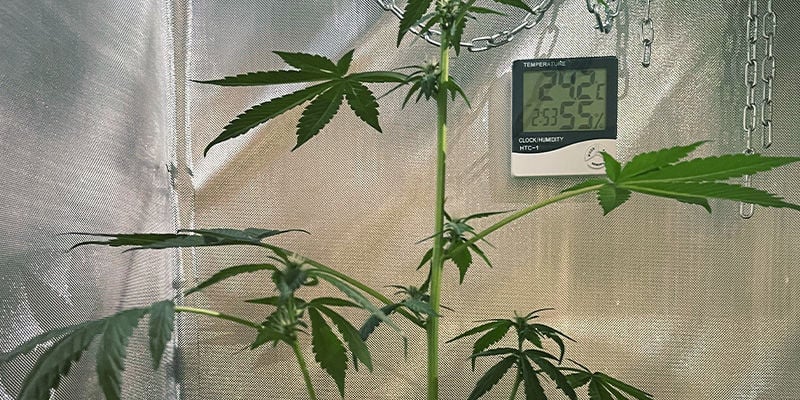
But why is that? Aren’t taller plants better? In the early stages, not necessarily. Seedlings and young vegging plants can grow weak, spindly stems that are more likely to snap, break, or topple over. From here, the health of your plants in general, not to mention their production potential, takes a hit.
Realistically, you want the vegetative stage to feature periods of both vertical and lateral growth, resulting in a plant capable of bearing an abundance of buds—not just skimming the ceiling with its impressive stature.
The other thing is, most indoor growers are limited on grow space, and simply don’t have the room to accommodate a light setup and a rapidly surging canopy. Likewise, even among outdoor growers who might have more vertical space to work with, the vast majority like to keep their operations clandestine—for a variety of reasons.
How to Prevent Stretching Weed Plants
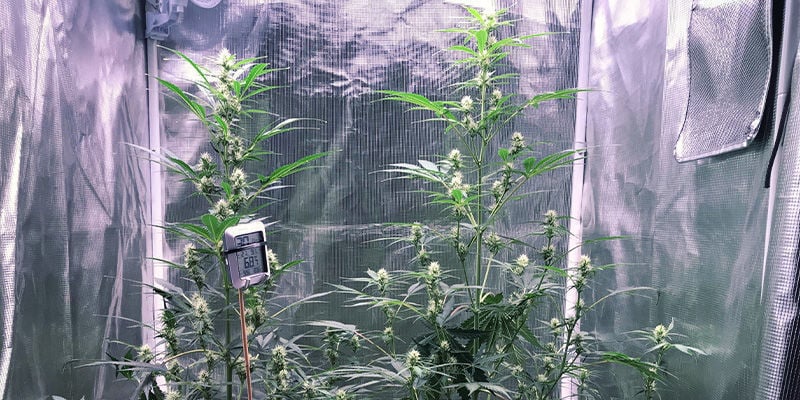
So, what can you do to prevent your precious cannabis plants from reaching for the stars? Again, there are both genetic and environmental factors to consider. By giving each one your full attention, you’ll be able to handle any stretching that does happen in a way that ultimately benefits your grow.
1. Pick Suitable Genetics
We mentioned that some strains are more likely to stretch than others, and that the indica/sativa divide isn’t enough to predict a plant’s stretching potential. Luckily, all hope is not lost. If you source your cannabis seeds from a reputable seed bank, you are more likely to grow stable seeds that exhibit predictable results.
The seed bank themselves will usually make a note of any strange behaviour associated with a strain—good or bad—that the grower should be aware of. So, if you are restricted on space or trying to keep things on the DL, go with reliable cannabis seeds that aren't expected to develop into super-stretchy plants.
2. Promote Air Circulation
Outdoors, despite the sometimes tumultuous elements at play, most cannabis plants stay upright and rooted in the soil. Believe it or not, a nice breeze does wonders for strengthening the internal part of the stem, causing tiny fractures that eventually build its thickness and rigidity. This way, if you happen to encounter extreme growth over a matter of hours, your plants should be able to withstand the spurt. Not only that; this breeze will also do its part to limit vertical growth as well.
In the grow room, you do not need an expensive setup to achieve adequate air circulation. If you’re only growing a couple of plants, a simple standing fan will do. Set on oscillate and watch your stems gain strength over the coming weeks.
3. Maximise Light Intensity (Without Burning Plants)
This technique is absolutely viable, but you must pay attention to avoid hurting your plants in other ways. As your cannabis will naturally reach for the sun, reducing the distance between the canopy and the light source will reduce stretching as well. Again, this is a balancing act if there ever was one. Depending on the type of light, different distances between the lamp and the canopy are advised. Stay within the lower end of this range to maximise light exposure without burning your plants or otherwise stunting their growth.
4. Keep Temperature in Check
Temperatures above 29°C spell trouble for stretching too; heat tends to cause stems to grow spindly and weak, and can initiate stretching on its own or further exacerbate an existing problem. This is why, in addition to keeping your grow room temps at an optimal range, you should also make sure your plants themselves aren’t being burned by hot lights. In other words, moving your lamps super close to your plants isn’t going to help your stretching problem either.
It’s always helpful to have a thermo-hygrometer to hand so you can consistently monitor the environmental conditions of your grow room. Cannabis thrives at different temperatures during its life cycle, so make sure you’re keeping temps within the desired range.
5. Shorten Veg Time
One surefire way to avoid excessive vertical growth is to shorten the veg phase of your photo-feminized plant. In fact, by choosing to grow in a SOG (many small plants in one grow space), you’ll essentially initiate bloom right from the beginning, limiting how much the plants can feasibly grow.
If you want your plant to gain some size before flipping to bloom, simply observe the point at which its current height, once doubled, is satisfactory for your requirements. Essentially, if you don’t want your plants to exceed a maximum height of two metres when all is said and done, flip them to bloom before they’ve hit a metre tall, in case they do decide to double their height.
6. Allow Proper Spacing Between Plants
Unless you decide to grow in a SOG, make sure to provide enough space for plants to grow uninhibited. If a plant is desperate for lateral space, it may compensate by going vertical. In general, adequate spacing is important when growing cannabis as it helps promote air circulation, ensuring plants have enough breathing room, as it were.
7. Cut Back on Nutrition and CO₂ Supplementation
If you’re looking to keep stretching to a minimum, it stands to reason that reducing the factors that fuel your plants’ growth could help you out here. Things like nutrients and CO₂ contribute to increased development, so cutting back on these variables during early bloom may keep stretching in check as a result. However, be sure to take this method with a grain of salt.
Ultimately, depriving your plants of key resources like water and nutes won’t enhance their health or development either; it’s about striking that balance of providing enough instead of too much. Ultimately, this should not be your first port of call to prevent stretching, but it’s an option to consider nonetheless.
8. Train Plants
If your plants aren’t listening to your pleas to stop stretching, or you're gearing up for a massive flowering stretch, some more hands-on attention may be necessary. Training and pruning allow you to control the shape of your plant by limiting vertical growth and generally keeping development under control.
Simple LST can be used to encourage lateral growth and optimal light exposure, or you can go one step further with a ScrOG—essentially an advanced form of LST. This way, as your plant moves from the late vegetative stage into early bloom, you will direct its branches through a mesh screen to optimise bud development while promoting almost exclusively lateral growth.
9. Change the Flowering Light Spectrum
As should be clear by now, light plays the largest environmental role in determining a plant’s propensity to stretch. And, some lights promote more stretching than others. Take a regular HID lighting setup for example. Growers will usually opt for metal halide (MH), which emits blue light, to support vegetative growth, before switching over to red high-pressure sodium (HPS) for flowering.
Now, once you switch to HPS, plants are much more likely to stretch significantly, as this change in light signals a natural changing of the seasons. To prevent stretching, you can consider using MH for the first few weeks of bloom. The blue light it emits will help to keep internodes short without inhibiting growth too much. This way, you can still benefit from the bud-boosting red light spectrum of HPS later on, but not so much that plants grow long, thin stems.
How to Fix and Support Stretching Cannabis Plants
We’ve done a lot of talking on prevention, and a little bit on mitigating this issue as it happens. Now it’s time to dig into some easy yet essential tactics and tools you can use to support a stretching cannabis plant.
1. Bury the Stem
Although it might almost seem a bit too obvious, if stretching becomes a problem, you can always bury the stem a bit deeper to reduce its length and add some support from the ground up. When doing this, you’ll want to be extremely careful not to damage the root system or the plant itself. Simply dig a deeper hole in your container or garden bed, and lightly compact the soil around the new base of the stem. Your plant will soon start to grow new shoots.
Alternatively, if you have a deep container with plenty of space at the top, you can add in more soil to cover more of the stem. This will save you from having to remove your plant from the substrate to dig a deeper hole.
2. Stakes
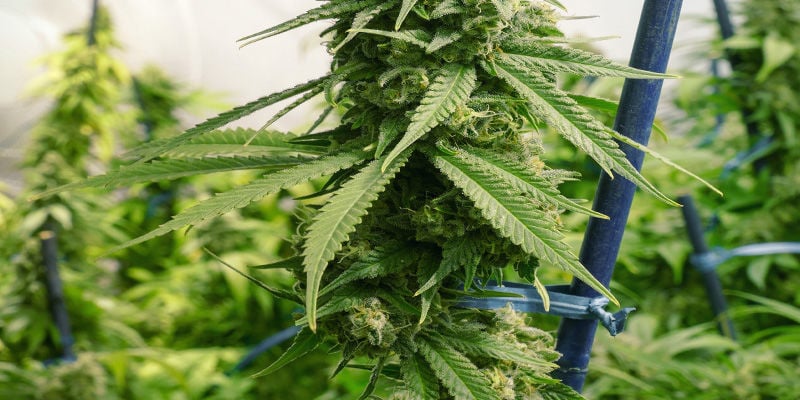
Stakes are the go-to method for any issues with plant support. Driving a stake or two into the soil can help direct and support plant growth, but it doesn’t have a 100% success rate. Depending on how far along your stretchy cannabis plant is, you may need to opt for a more supportive method, or a combination of staking and string, for example.
3. String
Using appropriate string and plant ties can be a life-saver throughout the growing season. Not only can it secure a stretchy stem, but it can also be used to support massive colas later on in the flowering phase. Every grower should manage to keep some gardening string around, just in case.
4. Trellises
Trellises take precautions a step further, using a vertical (or horizontal) setup to support plants as they grow. The mesh makeup of the trellis offers consistent support, which is why it is used in all sorts of botanical exploits to provide stability to plants. On that note, a ScrOG is basically just a horizontal trellis, and it’s not a bad grow method if you happen to encounter some stretching.
5. Tomato Cages
Tomato cages are ubiquitous, easy to work with, and have multiple purposes. In this case, they’re simply used to support the stems and branches of your stretching plant. If you grow outdoors, they can also help to keep larger pests away, such as deer and other mammals.
-
 7 min
16 February 2021
How And When To Low Stress Train Cannabis Plants
Low stress training, or LST, is a training method that involves bending and tying stems and branches to encourage more efficient and productive growth from cannabis plants. Here's how to do it.
7 min
16 February 2021
How And When To Low Stress Train Cannabis Plants
Low stress training, or LST, is a training method that involves bending and tying stems and branches to encourage more efficient and productive growth from cannabis plants. Here's how to do it.
-
 5 min
20 October 2020
The Optimal Distance Between Grow Lights And Cannabis Plants
Hanging a grow light in your grow room or tent is just one part of the story. To really get the most out of your cannabis plants, you need to hang your light at the optimal height to support robust...
5 min
20 October 2020
The Optimal Distance Between Grow Lights And Cannabis Plants
Hanging a grow light in your grow room or tent is just one part of the story. To really get the most out of your cannabis plants, you need to hang your light at the optimal height to support robust...
-
 3 min
17 October 2019
ScrOG Vs. SOG: Which Is Right For You?
When it comes to growing cannabis, advanced techniques like ScrOG and SOG can really help growers make the most of their plants. So let’s take a look at them both.
3 min
17 October 2019
ScrOG Vs. SOG: Which Is Right For You?
When it comes to growing cannabis, advanced techniques like ScrOG and SOG can really help growers make the most of their plants. So let’s take a look at them both.
-
 4 min
20 January 2019
Top 7 Lighting Factors For Growing Marijuana
Growing cannabis indoors gives you control over the environment. The need for precise lighting will make or break your harvest, so it also places more responsibility on you. Here are 7 lighting...
4 min
20 January 2019
Top 7 Lighting Factors For Growing Marijuana
Growing cannabis indoors gives you control over the environment. The need for precise lighting will make or break your harvest, so it also places more responsibility on you. Here are 7 lighting...
-
 4 min
22 March 2017
How To Have A Stress-Free And Successful Outdoor Stealth Grow
Outdoor cultivation can be an ideal way to keep a low key grow on the go - if you are careful about it. It's important to consider all the factors at play so that you can work with your plants free...
4 min
22 March 2017
How To Have A Stress-Free And Successful Outdoor Stealth Grow
Outdoor cultivation can be an ideal way to keep a low key grow on the go - if you are careful about it. It's important to consider all the factors at play so that you can work with your plants free...
-
 4 min
2 November 2016
The Ultimate Temperatures For Growing Cannabis
Optimal temperatures are essential for creating top-notch bud. Let's find out the details behind the thriving temps of cannabis plants, and how to achieve them.
4 min
2 November 2016
The Ultimate Temperatures For Growing Cannabis
Optimal temperatures are essential for creating top-notch bud. Let's find out the details behind the thriving temps of cannabis plants, and how to achieve them.





 United States
United States

